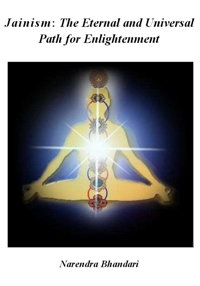One is many and many is one
Nature of the universe,
Macro and micro world,
Syādvād,
Saptabhangi
Jainism has given a unique concept of nature which is not found in any other thought. It is a deep conceptual doctrine, called Amekāntavād, stating that the nature is multidimensional, multifaceted, having infinite modes of manifestation, all existing at once i.e. at the same time. Everything we think, see or imagine is a manifestation of the same ultimate truth, although on the face of it, some facets may even appear mutually contradictory. It is not merely a doctrine but it is also a physical reality, a true and complete description of nature, unlike the sciences which give an incomplete or partial description, depending on what is being observed. It also has application in day to day life for harmony and understanding at personal, societal, national and spiritual levels. Much has been said in praise of Anekāntavād. Understanding of Anekāntavād is essential for getting correct world view or Samyagdarsan. Samyasar, one of the holiest scriptures of Jains, goes to the extent of saying that one who is equipped with anekānta attains Mokṣa,
"Any real object in the world is existent and non-existent (sat and asat), one and many, eternal and non-eternal (nitya and anitya), describable and indescribable (abhilāpya and anabhilāpya), neither this nor that, but both i.e. this as well as that in terms of its nature, time, pradesh (space) and material (swaroop, kāl, kshetra, dravya and bhāv)".
This is how Amritchandra described Anekāntavād. One may see a thing from any stand point (naya) and there are several nayas such as naigam naya (end use), samagra naya (universal or general view), vyavahār naya (practical view), rajusthra naya (current view), shabdnaya (synonymous view), samviruddha naya (etymological view) and avambhoot naya (simily view) etc. When these naya propositions or standpoints are formulated in an absolute way (this is it) and are claimed to be absolutely true, they become fallacies. Therefore each standpoint should be considered as only partial truth and is true only in relation to the context.
This theory of Anekāntavād has been variously described as the theory of many-foldedness, non-absolutism, non-equivocality and relativism. S. Mookerji calls it multifacedness and the theory of non-one sidedness, implying the many sided nature of reality. Some times Anekāntavād is contrasted with Ekāntavād which stands for definite and categorical asserted philosophical position, which as pointed out earlier would be wrong or partially true. In the physical world, as in philosophy, things or ideas have plurality of attributes and these can be apparently contradictory or conflicting. Anekāntavād successfully harmonises or accommodates such views and completes the description of the physical reality.
To understand this principle, let us turn to quantum mechanics. Physics divides the universe in two parts, the macro or gross and the micro or subtle (see Fig.7.1). The laws governing the macro world (galaxies, planets, rocks and whatever can be seen with eye, i.e. bigger than molecules and atoms) follow the laws of classical physics and the laws governing micro world (molecules, atoms, elementary particles etc. that cannot be seen with naked eye) are governed by quantum physics. The laws of classical and quantum mechanics are very different and will be discussed in some detail in Chapter 7 in a broader context of Jainism and modern physics. Here we confine to a scientific discussion relevant to Anekāntavād.
 |
Fig. 7.1 Macro to the micro universe showing the sequence from the gross to the subtle components of nature. Sixty Elementary Particles (Quarks, Leptons and the Force carriers, together with their antiparticles), known to be the building blocks of matter are arranged in the box according to their attributes. |
We see that gross matter has only a few properties. Anything we see has only two physical properties: weight and shape. As we go to smaller entities of matter constituting the micro world, like protons or electrons, they exhibit additional properties, like electric charge, wave - particle duality etc. The essence of this discussion is that in the domain of elementary particles, as one goes to finer and finer constituents of matter (from molecules to atoms to protons to quarks and so on), it exhibits more and more attributes (quantum states). It is difficult to perceive all of them at once, although they exist all the time. This is the true nature of reality. It is not possible to comprehend or quantify all these states at once. As we go further to the smallest particle, according to Jainism, the dimensionless paramanu, it may have infinite attributes, impossible to comprehend. This is not a limitation of instrument or technique of measurement, nor it is a limitation of consciousness of the observer, but it is due to the inherent nature of paramanu. It is possible that, for example, just as at atomic level wave-particle duality begins to manifest, at paramanu some new attributes of matter would arise. Energy also has many forms like heat, light, sound, kinetic, potential, nuclear etc. These seemingly contradictory attributes (wave-particle, energy-matter) may be the basic nature of matter. But Jainism does not permit mind-matter or consciousness-matter duality, that is, these two contradictory attributes are not the manifestation of the same "real". What then is matter? Logically we can argue that matter is a condensed form of light and light is a sublime form of matter. Light is energy and energy is an attribute of the soul, even so soul-matter duality is not acceptable to Jainism. According to Jainism, consciousness and matter i.e. sentient and non-sentient (Jiva and Ajiva) are independent, exclusive and eternal. Understanding the nature of the universe requires that we consider each of the attributes of matter as well as of consciousness to be partly true and all of the attributes have to be considered at once for a complete description.
Let us talk about the principle of Complementarity, a cornerstone of modern physics and Anekāntavād. The principle of Complementarity, is the most revolutionary and significant concepts of modern physics. Niels Bohr who propounded the basic principles of quantum mechanics had great difficulty explaining it and he used the principle of Complementarity to explain certain behavior in the micro world. For example, it can be experimentally shown that a photon (or electron) sometimes behaves as a compact particle and sometimes as a wave such as a ripple we see in a pond. A photon or an electron, for example, "knows" when it should behave like a particle and when it should behave like a wave. In the famous two slit experiment (see Fig. 7.2), a beam of photon shines through two slits and hits upon a photographic plate behind the slits. The experiment can be run in two ways: one with photon detectors right beside each slit so that the photons can be observed as they pass through the slits and/ or with the detectors removed, so that the photons can travel unobserved. When the detectors are in use, every photon is observed to pass through one slit or the other. Essentially the photons behave like particles. However, when the photon detectors are removed, a pattern of alternating light and dark spots, produced by interference of light are observed indicating that the photons behave like waves, with individual photon spreading out and surging against both the slits at once. The outcome of the experiment then depends on what the scientists want to observe, particle or wave nature of light.
 |
Fig. 7.2 The double slit experiment showing that photons (or electrons) act as particles when they are observed by particle detectors (D), giving the characteristic spots on the photographic plate (above), and waves when they go unobserved (below) giving rise to the well known interference pattern due to waves, proving the duality of behaviour of elementary particles. |
This dual behavior seems contradictory and western thinkers had lot of difficulty in explaining this seemingly contradictory nature of particles. Either it should be a material particle or a wave but cannot be both. Bohr explained this behavior by saying that contradictory behaviour is complementary and used the Chinese concept of Yin and Yang, which are both opposite but exist together and are required for complete description.
Anekāntavād goes a step further. Anekāntavād implies many foldedness. The question arises how many? Certainly more than one, but could it be infinite? It is not just two types of behavior (particle and wave nature of elementary particles) which needs to be explained but many (anek) or even infinite types of behaviour, manifested probably when we go down further to more subtle, smaller constituents of matter. As we have seen in the previous chapter, the soul is indivisible (akhand) and hence the minutest of everything that exists in the universe.
Anekāntavād not only explains seemingly contradictory propositions in daily life, philosophy, micro world, mental perception and in spiritual domain, but it brought in the concept of Avyakta or inexpressibility of certain states. Science has been developed on the basis that everything is logical and expressible and does not believe in inexpressibility of any characteristics. Questions which cannot be answered in affirmative or negative, like the existence of soul, could be dealt with in the framework of Anekāntavād. Anekāntavād is not simply a multiview perception theory. Neither it is a limitation of consciousness that it has limited capability of perception of the physical world but it is the true behavior of nature. Thus it is not looking at an object from different perspectives but implies that the object cannot be known from all the perspectives, at once.
Syādvād, a corollary of Anekānatavād, is a cornerstone of Jainism. Syadvad asserts that all answers are contextual and we may be nearer the truth when we say that "this too may be correct". It does not mean uncertainty but makes our understanding as certain and complete as it can be. Saptabhangi or sevenfoldedness is a corollary of Syādvād. Every answer should have seven possibilities. For anything, it is, it is not; it is and yet it is not, it is inexpressible (or indeterminable), its existence is indeterminable, its non-existence is indeterminable, its existence as well as non-existence is indeterminable are the seven possibilities. This concept is common to Quantum behaviour, which cannot always be expressed in language. This has been explained by D.S. Kothari in his essay on " Complementarity principle and Eastern philosophy".
In a nut shell, Anekāntvād asserts that "this is true and that also is true". Contrast it to upanishadik concept of neti. When asked what "God" is, the Upanishads, pointing at everything conceivable, says "Neti, Neti" neither this, nor that. None of the visible objects is God. In contrast Anekāntavād says This is partly true and That also is true.
Three different doctrines have been proposed in various eastern thoughts: Advaitavād (non-duality or monism), Dvaitavād (duality) and Anekāntavād (infinite possibilities).The universe consists of infinite type of things. The first proposition is that everything we see has emerged from one. Thus Advaitavād asserts that everything is a manifestation of "One". If in the beginning there was only "ONE", logically "many" (anek) cannot originate from "one" (Ek) because, nothing happens by itself. Without a cause, "ONE" would exist as it is for ever. For anything to happen to ONE, requires an outside agency. Existence of a cause, thus, requires something external of the ONE (i.e. at least "two"). Causality requires at least two to interact to give rise to "many", so "many" coming out of "one" violates causality. This proposition rejects "advaitavad" (non-duality, i.e. monism) and necessitates “dvaitavād” In this case everything emerges from the interaction of Purush and Prakriti. Anekāntavād goes a step further. It asserts that the "ONE" has infinite attributes and thus one and many are the same. It thus synthesizes Ekantvad (advaitavād), dvaitvad into Anekāntavād. Anekāntavād should truly be called Anantavād or theory of infinite possibilities. Thus Anekāntavād is a correct description of the physical reality and is necessary for understanding the nature of the ultimate constituents of nature.
 Prof. Dr. Narendra Bhandari
Prof. Dr. Narendra Bhandari
